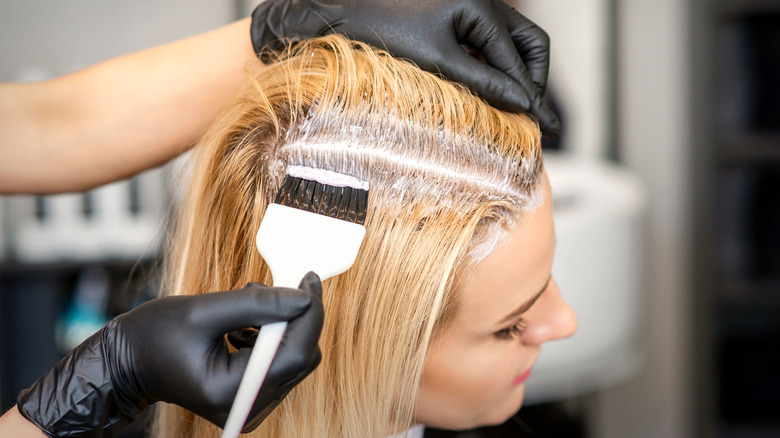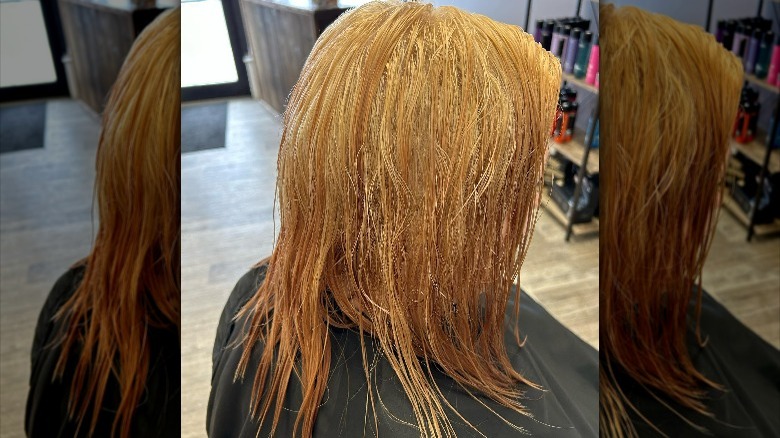How Bleaching Your Hair Can Become An Orange Nightmare
With blonde hair trending, lightening your hair at home might have seemed like a good idea. You found the perfect tutorial, got the products you needed, and started the process with confidence. However, when you washed out the bleach, your heart did a little more than start racing. Neon orange has nothing on the fiery locks staring back at you in the mirror.
You called a color correction specialist, but their soonest opening leaves you rocking that orange nightmare for a few days. In despair, you wonder where the process could have gone completely wrong, leaving you with a bleaching horror story. In truth, the process probably went as planned, but your hair might have been too dark for the process to remove all the reds, or it could be due to build-up.
When you see the beautiful light locks of your favorite brunette celebrities, like Kim Kardashian, you might not think that going from brunette to blonde is a big deal. But the truth is beaching from brunette to blonde is typically a multi-step process, and if you don't know what you're doing, you can end up looking like Carrot Top. To discover the cause of your new orange 'do, learn how and why bleaching can lead to brassy hair. Get a few quick fixes to help you to neutralize the warm tones so the beanie doesn't need to come out to play. Additionally, since bleach can be so damaging, it's always best to contact a professional stylist when considering going blonder.
Why hair turns orange when bleaching
To understand brassy hair, one has to understand how hair lightening works. When bleach is applied to hair, it cause a chemical reaction that strips the hair of melanin, aka the pigment that gives your brunette hair its color. According to John Freida, those warm orange and red pigments that make your brunette hair come to life in the sunlight are also the hardest for bleach to eliminate. Therefore, it's always best to talk to a cosmetologist about going from brunette to blonde to ensure the process is completed perfectly.
While having darker hair is the most common reason your tresses came out orange after bleaching, it's not the only reason out there. Dark blondes going to light blonde can also encounter the dreaded brassiness. This typically has less to do with the hair shaft's orange molecules and more to do with hair mineral build-up. In addition to hard water build-up, John Freida pointed out how pools with chlorine and salt water can lead to brassiness in blondes. With the reason behind your brassy situation nailed down, it's time to fit it ASAP.
Simple ways to fix orange hair
Beautiful light wisps of hair don't just magically appear when the bleaching process is complete. There's an essential step that takes your hair from brassy or straw-colored to gorgeous creamy blonde. And this step is the toner.
Toning your hair is all about the color wheel; therefore, it's vitally important that you use the right toner to go from outrageous orange to beautiful blonde. When you take a look at the color wheel, the color opposite orange is blue, and the color opposite yellow is purple. So, if you have bright orange hair, use a blue shampoo at home to help you go more ashy. For yellow hair, use purple shampoo to give you a more white look. Your stylist might also mix the two to properly neutralize those warm tones.
Beyond toning your hair, an orange nightmare might mean you must hit the bleaching process again to pull those remaining orange pigments if you're dead set on white blonde. Consult a professional if you brave this step since a second bleaching process can lead to further damage and breakage. Another option is to add color to your hair by dyeing it a warmer color or adding red to warm up those brassy hues. No matter what solution you choose, it's essential to give your hair lots of extra moisture and nutrients through masks and special shampoos to combat bleach damage. While bleaching can leave you with an orange mess, you have a few options to fix the problem.

